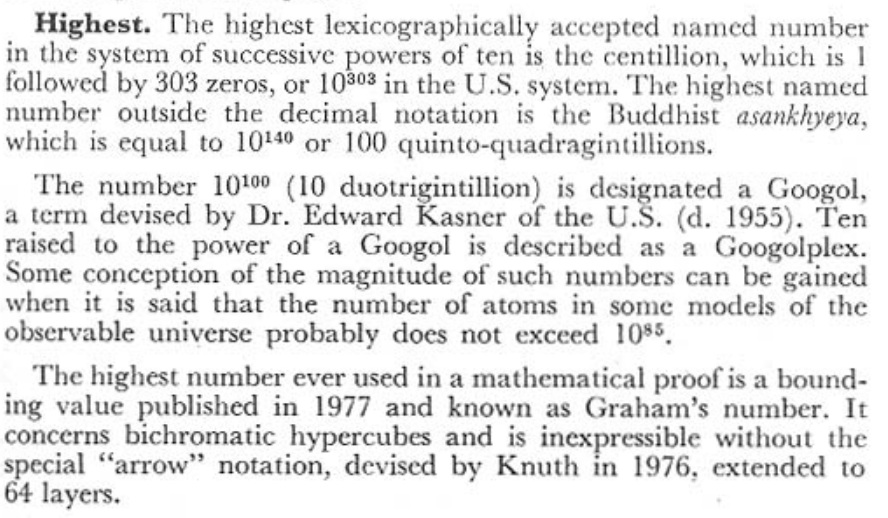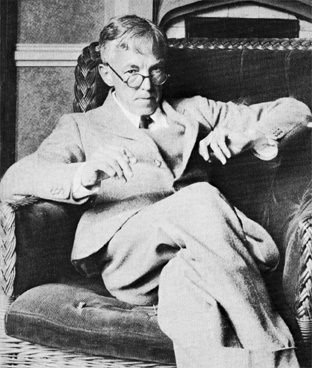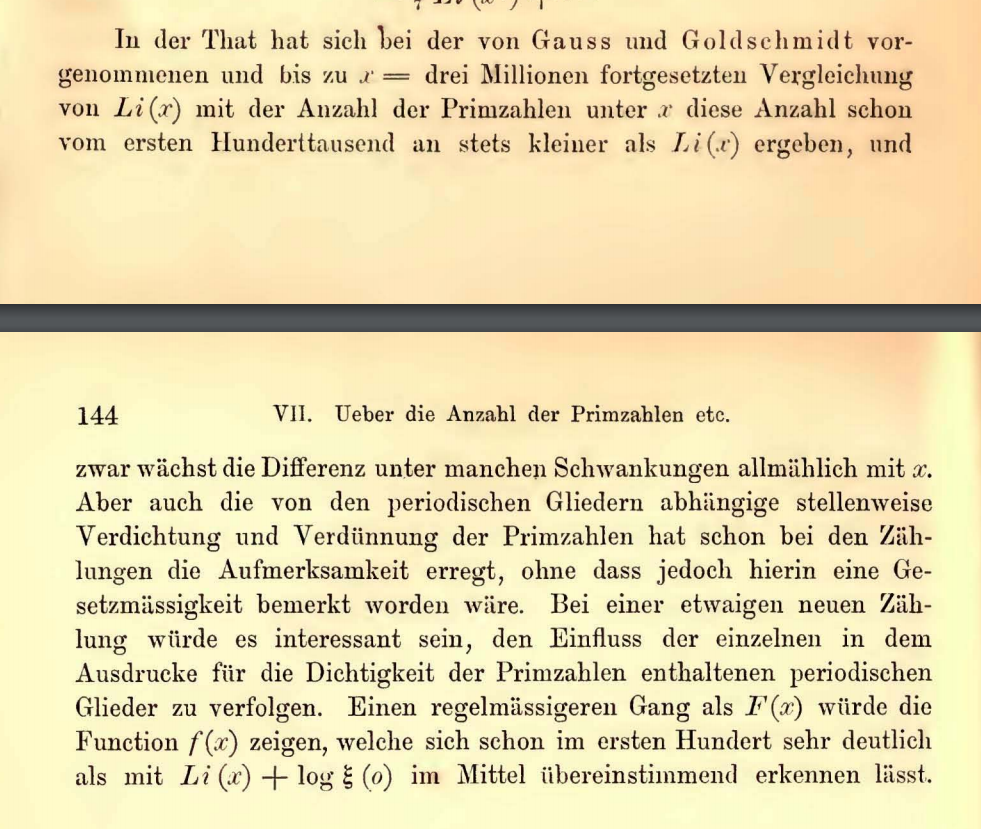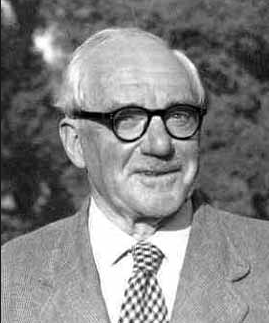The Large Number on Prime Numbers:
Skewes Number


@Riemann_Zeta_F
\displaystyle
\pi (x) = \sum_{m = 1}^{\infty} \frac{\mu(m)}{m} \left(\mathrm{li} (x^{\frac{1}{m}}) - \sum_{\rho} \mathrm{li} (x^{\frac{\rho}{m}}) + \int_{x^{\frac{1}{m}}}^{\infty} \frac{1}{t(t^{2} - 1)} dt - \log 2\right)
π(x)=m=1∑∞mμ(m)(li(xm1)−ρ∑li(xmρ)+∫xm1∞t(t2−1)1dt−log2)
\displaystyle
\pi (x) < \mathrm{Li} (x)
π(x)<Li(x)
\displaystyle
\mathrm{Li} (x) - \frac{1}{2} \mathrm{Li} (x^{\frac{1}{2}}) - \frac{1}{3} \mathrm{Li} (x^{\frac{1}{3}}) - \frac{1}{5} \mathrm{Li} (x^{\frac{1}{5}}) + \frac{1}{6} \mathrm{Li} (x^{\frac{1}{6}})
- \cdots
Li(x)−21Li(x21)−31Li(x31)−51Li(x51)+61Li(x61)−⋯
\displaystyle
\zeta (s) = \sum_{k = 1}^{\infty} \frac{1}{k^{s}}
ζ(s)=k=1∑∞ks1
\displaystyle
\pi (e^{e^{e^{79}}}) > \mathrm{Li} (e^{e^{e^{79}}})
π(eee79)>Li(eee79)
?
?
\displaystyle
\pi (x) \sim \frac{x}{\log x}
π(x)∼logxx
2017. 10. 08.
@Romantic Mathnight
in
\displaystyle
\mathrm{MATH~ POWE}\mathbb{R}^{2017}
MATH POWER2017
\displaystyle
\mathrm{def}
def
\displaystyle
L \left(s + \frac{n - 1}{2};~\left(\mathrm{Sym}^{n - 1} \rho_{E, \ell}\right)|_{F'}\right) = L (s; \mathrm{\Pi}_{m, n})
L(s+2n−1; (Symn−1ρE,ℓ)∣F′)=L(s;Πm,n)

自己紹介.
・14歳, 中学2年生.
・去年の7月にある2人の日曜数学者のブログを見て,
数学に興味を持つ.
・去年の12月24日, 今年の7月1日のロマ数でプレゼン.
・最近は佐藤-Tate予想周辺を勉強中.
・グレブナー基底にはポン酢派.

Skewes Number
・めっちゃでかい
・素数定理と関係がある
・Riemann zetaの と関係がある
\displaystyle
\rho
ρ
・具体的な値は未だ知られていない

でかい数
ある数をでかくするためにいろいろな演算子が導入されてきた:
たしざん
a + b
a+b
かけざん
\displaystyle
a \times b = a + a + \cdots + a
a×b=a+a+⋯+a
(
\displaystyle
b
b
回
)
\displaystyle
+
+
\displaystyle
\times
×
べきじょう
\displaystyle
\uparrow
↑
\displaystyle
a \uparrow b = a \times a \times \cdots \times a
a↑b=a×a×⋯×a
(
\displaystyle
b
b
回
)
\displaystyle
a^{b}
ab
テトレーション
\displaystyle
\uparrow \uparrow
↑↑
\displaystyle
a \uparrow \uparrow b = a \uparrow a \uparrow \cdots \uparrow a
a↑↑b=a↑a↑⋯↑a
(
\displaystyle
b
b
回
)
\displaystyle
^{b}a
ba
\displaystyle
\cdots
⋯

でかい数
\displaystyle
\uparrow
↑
を増やすとつよい
\displaystyle
3 + 3 = 6
3+3=6
\displaystyle
3 \times 3 = 3 + 3 + 3 = 9
3×3=3+3+3=9
\displaystyle
3 \uparrow 3 = 3 \times 3 \times 3 = 27
3↑3=3×3×3=27
\displaystyle
3 \uparrow \uparrow 3 = 3 \uparrow 3 \uparrow 3 = 3 \uparrow 27 = 7625597484987
3↑↑3=3↑3↑3=3↑27=7625597484987
\displaystyle
3 \uparrow \uparrow \uparrow 3 = 3 \uparrow \uparrow 7625597484987 = \cdots
3↑↑↑3=3↑↑7625597484987=⋯

でかい数
\displaystyle
\uparrow
↑
を
\displaystyle
x
x
個並べるともっとつよそう
\displaystyle
f (x) = 3 \uparrow \uparrow \cdots \uparrow 3
f(x)=3↑↑⋯↑3
\displaystyle
\mathrm{def}
def
\displaystyle
f (x)
f(x)
を 入れ子 みたいにするともっとつよい
\displaystyle
f (f(3)) = 3 \uparrow \uparrow \cdots \uparrow 3
f(f(3))=3↑↑⋯↑3
(
\displaystyle
x
x
回
)
(
\displaystyle
3 \uparrow \uparrow \uparrow 3
3↑↑↑3
回
)
\displaystyle
=
=
ウワーッ

でかい数
\displaystyle
f (x)
f(x)
を 64 layers の 入れ子 にしたやつ
x = 4
x=4
(
)
Graham Number
数学の証明で使われた一番大きい数としてギネス世界記録に認定

(1980)
http://math.ucsd.edu/~fan/ron/images/record.jpg

Skewes Number

"The largest number which has ever served any definite purpose in mathematics."
G. H. Hardy
1877 - 1947


Prime Number

Prime Number
Definition.
\displaystyle
1
1
とその数自身の2つ以外に約数をもたない自然数のことを,
素数とよぶ.
Theorem. (Euclid, 3 BC.)
素数は無数に存在する.

Prime Number
Theorem. (Euclid, 3 BC.)
全ての自然数は, 素数の積としてただ一通りに
表すことができる.

Prime Number
Theorem. (Euclid, 3 BC.)
全ての自然数は, 素数の積としてただ一通りに
表すことができる.
Example.
\displaystyle
57 = 3 \times 19,
57=3×19,
\displaystyle
49 = 7 \times 7,
49=7×7,
\displaystyle
91 = 7 \times 13.
91=7×13.

Prime Number
Conjecture. (Gauß, 1792?)
\displaystyle
\pi (x) = \# \{p \leqq x ~ | ~ p : \mathrm{prime} \}
π(x)=#{p≦x ∣ p:prime}
\displaystyle
\mathrm{def}
def
に対して,
\displaystyle
\pi (x) \sim \frac{x}{\log x} ~~~ (x \to \infty).
π(x)∼logxx (x→∞).
この ``ニョロン" は
\displaystyle
\lim_{x \to \infty} \frac{\pi (x)}{x / \log x} = 1
x→∞limx/logxπ(x)=1
という意味.

Prime Number
\displaystyle
\pi (x)
π(x)
\displaystyle
x
x
比
\displaystyle
\frac{\pi (x)}{x/\log x}
x/logxπ(x)
\displaystyle
10
10
\displaystyle
4
4
\displaystyle
0.921
0.921
\displaystyle
10^{2}
102
\displaystyle
10^{3}
103
\displaystyle
10^{9}
109
\displaystyle
10^{24}
1024
\displaystyle
25
25
\displaystyle
168
168
\displaystyle
50847534
50847534
\displaystyle
18435599767349200867866
18435599767349200867866
\displaystyle
1.151
1.151
\displaystyle
1.161
1.161
\displaystyle
1.054
1.054
\displaystyle
1.019
1.019

Prime Number
Theorem. (Hadamard-de la Valèe Poussin, 1896)
予想は正しい.
これを 素数定理 とよぶ.
証明には Riemann zeta が使われた.

Riemann zeta

Bernhard Riemann
1826 - 1866
``Über die Anzahl der Primzahlen unter einer gegebenen Größe"

Riemann zeta
Definition.
\displaystyle
\zeta (s) = \sum_{k = 1}^{\infty} \frac{1}{k^{s}} ~~~~~ (\mathrm{Re} (s) > 1).
ζ(s)=k=1∑∞ks1 (Re(s)>1).
Theorem. (Euler, 1734.)
\displaystyle
\zeta (2) = \frac{\pi^{2}}{6}.
ζ(2)=6π2.
\displaystyle
\mathrm{def}
def

Riemann zeta
Theorem. (Apéry, 1978.)
\displaystyle
\zeta (3) \notin \mathbb{Q}.
ζ(3)∈/Q.
Theorem. (Zudilin, 2001.)
\displaystyle
\zeta (5), ~ \zeta (7), ~ \zeta (9), ~ \zeta (11)
ζ(5), ζ(7), ζ(9), ζ(11)
のどれか1つは無理数.

Riemann zeta
Theorem. (Euler, 1737.)
\displaystyle
\zeta (s) = \prod_{p} \frac{1}{1 - \frac{1}{p^{s}}}.
ζ(s)=p∏1−ps11.

Riemann zeta
Theorem. (Riemann, 1859.)
\displaystyle
\pi^{-\frac{s}{2}} \Gamma \left(\frac{s}{2}\right) \zeta (s) = \pi^{-\frac{1 - s}{2}} \Gamma \left(\frac{1 - s}{2}\right) \zeta (1 - s).
π−2sΓ(2s)ζ(s)=π−21−sΓ(21−s)ζ(1−s).

Riemann zeta
Theorem. (Riemann, 1859.)
\displaystyle
\displaystyle \zeta (s) = 2^s\pi^{s-1}\sin \frac{\pi s}{2}\Gamma (1-s)\zeta (1-s).
ζ(s)=2sπs−1sin2πsΓ(1−s)ζ(1−s).
\displaystyle
-2n \cdots
−2n⋯
自明な零点.
\displaystyle
\rho \cdots
ρ⋯
非自明な零点.
\displaystyle
0 \leqq \mathrm{Re}(\rho) \leqq 1.
0≦Re(ρ)≦1.
Theorem.

Riemann zeta
Conjecture. (Riemann, 1859.)
\displaystyle
\mathrm{Re} ( \rho) = \frac{1}{2}.
Re(ρ)=21.


Riemann zeta
Theorem. (Riemann, 1859.)
\displaystyle
\pi (x) = \sum_{m \leqq \log_{2} x} \frac{\mu(m)}{m} \left(\mathrm{li} (x^{\frac{1}{m}}) - \sum_{\rho} \mathrm{li} (x^{\frac{\rho}{m}}) + \int_{x^{\frac{1}{m}}}^{\infty} \frac{1}{t(t^{2} - 1)} dt - \log 2\right).
π(x)=m≦log2x∑mμ(m)(li(xm1)−ρ∑li(xmρ)+∫xm1∞t(t2−1)1dt−log2).

Prime Number Theorem
Theorem. (Hadamard-de la Valeè Poussin, 1896)
に対して
\displaystyle
\mathrm{Re} (s) = 1
Re(s)=1
\displaystyle
\zeta (s) \neq 0.
ζ(s)̸=0.
この事実から素数定理が証明される.

Prime Number Theorem
その後の影響.
Deligne (1974) - Weil Conjectures
Taylor et al. (2011) - Sato-Tate Conjecture
絶対収束域ギリギリの線上での非零性から,
数論的な帰結を得る.

Prime Number Theorem
素数はとてもおもしろい. それは,
・とても不規則に並んでいて, 次に何が出てくる
というところと,
かわからない,
・とても規則的に並んでいる
というところにある.
Don Zagier:

Prime Number Theorem
Dirichlet達は次の関数を考えた:
\displaystyle
\mathrm{Li} (x) = \int_{2}^{x} \frac{1}{\log t} dt.
Li(x)=∫2xlogt1dt.
\displaystyle
\mathrm{def}
def
†
\displaystyle
\pi (x) \sim \frac{x}{\log x} ~~~ (x \to \infty) \Longleftrightarrow \pi (x) \sim \mathrm{Li} (x) ~~~ (x \to \infty)
π(x)∼logxx (x→∞)⟺π(x)∼Li(x) (x→∞)

Prime Number Theorem
\displaystyle
\mathrm{Li} (x)
Li(x)
は
を非常に良く近似する:
\displaystyle
\pi (x)
π(x)
\displaystyle
\pi (10) = 4
π(10)=4
\displaystyle
\mathrm{Li}
(10) = 5
Li(10)=5
\displaystyle
\pi (100) = 25
π(100)=25
\displaystyle
\mathrm{Li} (100) = 29
Li(100)=29
\displaystyle
\pi (1000000000) = 50847534
π(1000000000)=50847534
\displaystyle
\mathrm{Li} (1000000000) = 50849234
Li(1000000000)=50849234
\displaystyle
\pi (x) < \mathrm{Li} (x)
π(x)<Li(x)
にみえる.
Gaußはこの関係が常に成り立つと予想した.
まで正しい.
\displaystyle
x = 3000000
x=3000000

Prime Number Theorem
Riemann:


Prime Number Theorem
Riemann:


Prime Number Theorem

Theorem. (Littlewood, 1914.)
は無限回符号を変える.
\displaystyle
\pi (x) - \mathrm{Li} (x)
π(x)−Li(x)
John Edensor Littlewood
(1875 - 1977)
Skewesの指導教官.

Prime Number Theorem
Theorem. (Skewes, 1933.)
は
\displaystyle
\pi (x) > \mathrm{Li} (x)
π(x)>Li(x)
なる
\displaystyle
x
x
\displaystyle
e^{e^{e^{79}}} = 10^{10^{10^{34}}}
eee79=10101034
以下に存在する.
これがSkewes number.

Prime Number Theorem
評価の改良:
Skewes (1955)
\displaystyle
x \leqq e^{e^{e^{e^{7.705}}}} = 10^{10^{10^{963}}}
x≦eeee7.705=101010963
Lehman (1960)
\displaystyle
x \leqq 1.65 \times 10^{1065}
x≦1.65×101065
te Riele (1987)
\displaystyle
x \leqq 6.69 \times 10^{370}
x≦6.69×10370

Prime Number Races

Prime Number Races
\displaystyle
\mod 3
mod3
Race.
Team
\displaystyle
1
1
\displaystyle
2, 5, 11, 17, 23, 29, 41, 47\cdots
2,5,11,17,23,29,41,47⋯
Team
\displaystyle
2
2
\displaystyle
7, 13, 19, 31, 37, 43, 61, \cdots
7,13,19,31,37,43,61,⋯

Prime Number Races
\displaystyle
\mod 3
mod3
の素数を数える:
\displaystyle
\pi_{3, ~ 2}^{\mathrm{mod}} (x)
π3, 2mod(x)
\displaystyle
\pi_{3, ~1}^{\mathrm{mod}} (x)
π3, 1mod(x)
\displaystyle
x
x
\displaystyle
100
100
\displaystyle
11
11
\displaystyle
13
13
\displaystyle
80
80
\displaystyle
87
87
\displaystyle
1000
1000
\displaystyle
611
611
\displaystyle
617
617
\displaystyle
10000
10000
\displaystyle
100000
100000
\displaystyle4784
4784
\displaystyle
4807
4807
\displaystyle
1000000
1000000
\displaystyle
39266
39266
\displaystyle
39231
39231

Prime Number Races
\displaystyle
\mod 3
mod3
の素数レースは, 無限回符号が
入れかわることが知られている.
最初に入れかわる数:
\displaystyle
x = 608981813029.
x=608981813029.
1976年のクリスマスに, Bays, Hudsonによって発見された.

Thank you for your attention!
Skewes Number @.Romantic Mathnight in Math Powe\mathbb{R}^{2017}
By zeta_aniki
Skewes Number @.Romantic Mathnight in Math Powe\mathbb{R}^{2017}
酢kewe酢酢
- 3,051



